[ad_1]
Japan has a rich culture that they have preserved for many generations. Today, they still practice many rituals and festivals their ancestors passed down. A key part of Japanese culture is the instruments used to play traditional Japanese music.
There are many traditional Japanese instruments still being used today. These include stringed instruments, such as the Koto, wind instruments, such as the Shakuhachi, and percussion instruments, such as Wadaiko. Most of these instruments require in-depth training and are taught in Japanese schools.
In this article, we will explore the most famous Japanese instruments used today. We’ll briefly talk about their history and where they are used in modern-day Japan
Traditional Japanese Instruments
Koto (箏)
The “Koto” or “Kin” is a Japanese longboard zither that usually has 13 silk strings and a moveable bridge. It is notable for being the national instrument of Japan. It is derived from the Chinese instruments “guzheng” and “se”.
The Koto usually has a length of 180 centimeters and is made of Paulownia wood (known as “Kiri” 桐 in Japan). The Koto uses movable bridges made from ivory. These bridges act as the tuning keys for the strings of the Koto.
Also Read: Koto – The Sound of Traditional Japanese Courts
In addition, the Koto is similar to other Asian national instruments, such as Mongolia’s “yatga”, Korea’s “gayageum” and “ajaeng”, Vietnam’s “đàn tranh”, and Kazakhstan’s “jetigen”.
The Japanese Koto also has a 17-string variant called the “jūshichigoto” or “jūshichi-gensō (十七絃箏)” that acts as bass in orchestral pieces. The 17-string variant of the Koto was invented by Miyagi Michio (1894–1956) from the Ikuta school that was started in the 17th century.
The Koto was originally from China and was introduced to Japan in the 7th century. The early version of the Koto had five strings and eventually increased to seven strings.
During this period, the Japanese used to call any Japanese stringed instruments “koto”, but eventually, the term came to mean specifically the modern Koto, derived from the gakusō used in Japanese court music (Gagaku).
Shamisen (三味線)
The Shamisen is a stringed instrument constructed similarly to the structure of a guitar or banjo. The neck of the Shamisen is significantly thinner compared to modern guitars.
The body of the Shamisen is hollow and shaped similarly to a drum. The Shamisen’s body is constructed using different types of skins, depending on the genre it is used in.
Shamisen manufacturers originally used animal skin from dogs and cats. However, since the 2000s, many Shamisen builders no longer use animal skin. Instead, they use synthetic replacement materials.
There are different types of Shamisen. The main ones are “hosozao”, “chuzao”, “futozao”, and “heike-shamisen”.
These different types of Shamisen have different shapes, sizes, materials used, and tuning. Each type of Shamisen is used for different genres. The Shamisen can be played with fingers, or a large plectrum called “bachi” (バチ).
Also Read: Shamisen – The Japanese Banjo
Japanese historians believe that the Shamisen was originally developed from a Chinese instrument called “sangen” (三弦), which made its way to Okinawa Prefecture during the late 14th or 15th century.
Upon reaching Japan, it became known as the “Sanshin” (三線) and was used by the Ryukyuan monarchy, who were the rulers of Okinawa from the 15th to 19th century. During the 16th century, the Sanshin became popular throughout Japan and came to be known as the Shamisen.
Gottan (ゴッタン)
The Gottan, also known as the “Box Shamisen” (Hako Shamisen) or “Board Shamisen” (Ita Shamisen), is a three-stringed traditional Japanese instrument. As its other names suggest, it is believed by the Japanese to be a relative of the Chinese Sanshin that later became the Shamisen.
The Gottan is often used in traditional Japanese folk songs. In the past, it was used for door-to-door busking, known as “kadozuke”.
Kokyu (胡弓)
The Kokyu is the only traditional Japanese instrument played with a bow. The other Japanese instruments in this list are usually played with fingers or a plectrum. The Kokyu is similar in many ways to a Shamisen.
Both its shape and construction are similar to a Shamisen. The main difference between the structure of the two is that the Kokyu is smaller and produces notes an octave higher than a Shamisen.
Shop Japanese Musical Instruments Today
The Kokyu’s neck is made of ebony. Its hollow body is made of coconut or Japanese Snowbell wood. Cat skin is then used to cover both ends of the body of the Kokyu, though snakeskin is often used in Okinawa instead, giving Okinawan variants a unique appearance.
The Kokyu was often used in ensembles along with the Koto and Shamisen, though after the 20th century, Shakuhachis are used more often than Kokyus in ensembles. However, it is still common to see Kokyus in traditional Japanese music.
Sho (笙)
The Sho is a Japanese wind instrument/flute used for Japanese Imperial Court music, called Gagaku. It is made of 17 bamboo pipes bound in wood strips attached to a metal and wooden chassis called a “Fukube”. A mouthpiece is attached to the Fukube, and 15 of the 17 pipes have metal ends called “Shita”.
Also Read: Sho – The Strange Japanese Flute
The Sho is believed to originate from China and is a descendant of a Chinese instrument called the “Sheng”. The Sho was introduced to Japan during the Nara period (AD 710 to 794).
Japanese Sho ensembles mostly disappeared after the Onin War in 1477, but eventually returned during the rise of the Tokugawa Shogunate in 1603.
Shakuhachi (尺八)
The Shakuhachi is a Japanese wind instrument/flute played by blowing straight into its end. Due to its cultural impact, it is considered one of Japan’s most important traditional instruments.
The Shakuhachi is traditionally made of bamboo roots. However, modern Shakuhachi builders have also utilized hardwood.
The Shakuhachi has five finger holes, four of which are found on the front, with the remaining one found at the back. Players cover these holes with their fingers to change the note produced. The Shakuhachi’s main difference from western-style flutes is that it is played vertically.
The Shakuhachi is quite flexible and can play many different notes. However, it is usually tuned to a minor pentatonic scale commonly used in traditional East Asian music.
Historians believe that a Chinese Buddhist Monk invented the Shakuhachi. It first made its way into Japan during the 7th century, when it was used for Gagaku performed at imperial courts. It was also popular in Zen Buddhism.
Buy Shakuhachi From Japan Now!
Biwa (琵琶)
The Biwa is a short-necked wooden stringed instrument/lute used for narrative storytelling. It has been played for centuries and is believed to be a Chinese instrument that made its way to Japan during the Nara period (710-794).
The Japanese Biwa commonly has four strings and is played using a “bachi”. It is mostly used for the Japanese classical music “Gagaku (雅楽)”.
Buy Instruments From Japan Today
There are three types of Japanese Biwa depending on what they are used for in Japanese culture. These three types are “Classic Biwas”, “Edo Biwas”, and “Modern Biwas”.
Music utilizing the Biwa uses a pentatonic or five-note scale. Interestingly, Biwa-based music and tradition were mostly abandoned in the 1940s and were replaced by Western-style music and traditions. But today, the Biwa-based music and Japanese tradition are being restored by Japanese musicians.
Wadaiko (和太鼓)
Wadaiko (和太鼓) is a family of traditional Japanese drums often seen in live musical performances at summer festivals. The Japanese word “Taiko (太鼓)” literally translates to “drum”, while “Wadaiko (和太鼓)” specifically refers to traditional Japanese drums & drumming. However, outside of Japan the more general term “Taiko (太鼓)” is often used to refer to both the Japanese drums specifically, and the Japanese art of ensemble drumming called “Kumi-Daiko (組太鼓)”.
Japanese historians believe the Taiko was already present in Japan as early as the Jomon period (14,000-300 B.C.). The Japanese historical records show that the Taiko was not only a musical instrument but also a device used for communication.
Shop Wadaiko Kodo Music & Goods
According to these records, the ancient Japanese used the Taiko to communicate with their ancestors during rituals. Later on, the Taiko was predominantly used in the Japanese military. It was used to indicate special announcements or to rally and inspire troops.
Eventually, the Buddhist and Shinto religions adopted the Taiko as a sacred instrument. During the Showa era (post-war Japan), Japanese Jazz drummer Daihachi Oguchi created the ensemble drumming style known as kumi-daiko, using various sizes and designs of Japanese drums, such as the barrel-shaped Naga-dō daiko (長胴太鼓), high-pitched Shime-daiko (締太鼓), tube-shaped Okedōdaiko (桶胴太鼓) and others.
Today, the Taiko is used in Gagaku, with performances in the Tokyo Imperial Palace and at various temples and shrines.
Additionally, the Taiko has gained global recognition thanks to the Japanese video game/arcade rhythm game series “Taiko no Tatsujin” (太鼓の達人). The video game lets players play the Taiko through the rhythm of many famous modern J-Pop, Anison (Anime Song/Music), Japanese video games, and many more.
Horagai (法螺貝)
The Horagai, also known as Jinkai (陣貝), is a Japanese shell trumpet used by Buddhist Monks and Japanese Feudal Warriors. These shell trumpets are made of Charonia tritonis sea snails’ shells and have been used in Japan for centuries. Unlike seashell trumpets from other countries and cultures that only produce one note, the Horagai can produce up to five notes.
Buddhist Monks used the Horagai for ceremonies, while Japanese samurai used them to set the pace and rhythm for marching and inspire troops during battles. Today, only a handful of Japanese schools continue to teach using the Horagai.
Also Read: 3 Must-Visit Traditional Japanese Festivals
Naruko (鳴子)
The Naruko is a traditional wooden Japanese instrument used in festivals. Unlike most Japanese instruments in this list, the Naruko is a simple instrument that does not require precision, training, or practice. It is pretty much a simple instrument made to produce a clapping sound.
In the past, farmers used Narukos to scare birds away from their crops. Eventually, the Naruko became less of an agricultural tool and more of a festival icon. Specifically, Narukos are used at the Yosakoi Dance Festival held in Kochi Prefecture in Mid-August each year.
Kane (鉦)
The Kane is a disc-shaped Japanese percussion instrument used in Buddhist ceremonies, Gagaku, and ritual events. Like most traditional Japanese instruments, the Kane originated from China. Also, the Kane is an old instrument used in Asia for centuries.
The Kane is played by hitting it with a mallet made of wood or animal horn. Like modern percussion instruments, hitting different parts of the Kane creates different sounds. Today, the Kane is most notably used at the Awa Odori, where it is played alongside other traditional Japanese instruments, such as the Taiko and Shamisen.
Otamatone (オタマトーン)
The Otamatone (オタマトーン) is a real alien in the Japanese musical landscape. Unlike the traditional instruments presented above, it is an electronic musical instrument – a kind of synthesizer recently developed in Japan by the Cube Works company.
Also Read: Collaboration Kirby Edition Otamatone
To play, you have to use both hands: one hand holds and squeezes the “head”, the other controls the pitch by sliding your finger along a bar placed on the shaft and the sound emerges from a kind of mouth on the notehead.
There are several colored versions and some featuring characters like Kirby, Hatsune Miku or Kumamon.
[ad_2]
Source link





